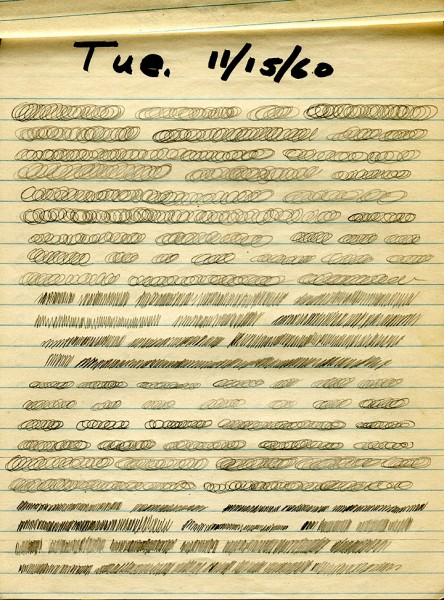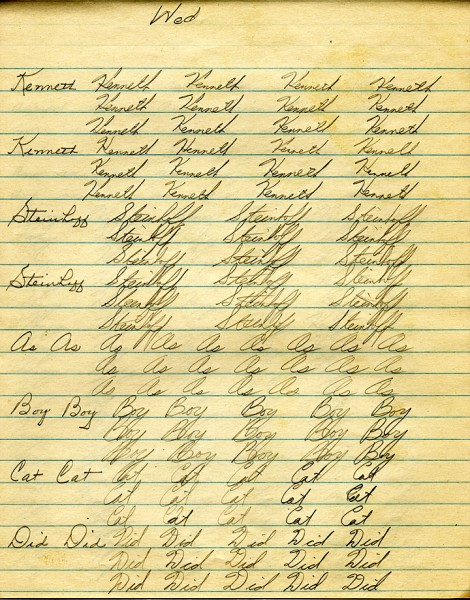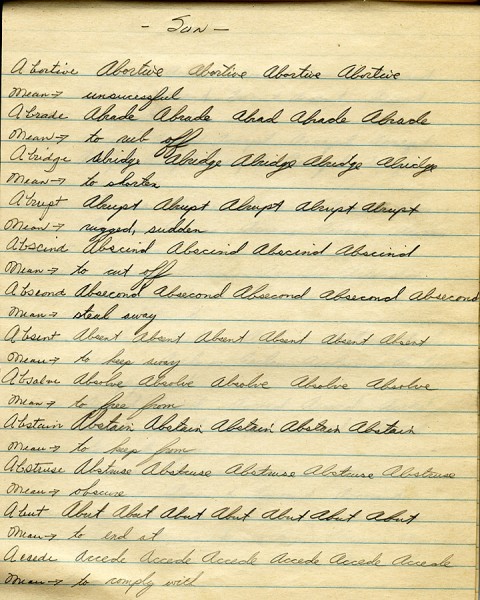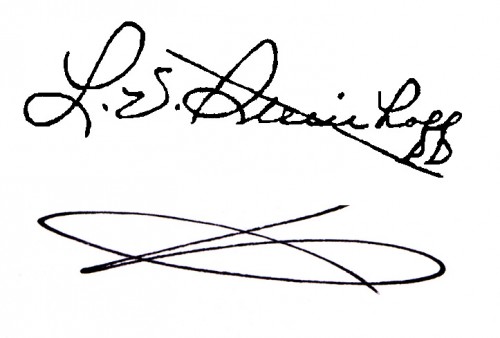 Reader Madeline DeJournett posted a link on Facebook to a Psychology Today story entitled “What Learning Cursive Does for Your Brain.” The story whines that schools are phasing out the teaching of cursive writing.
Reader Madeline DeJournett posted a link on Facebook to a Psychology Today story entitled “What Learning Cursive Does for Your Brain.” The story whines that schools are phasing out the teaching of cursive writing.
Madeline, a former school teacher, opines: “Can you imagine that they would give it up? It is a sad state of affairs, when our dependency on technology and machines cause us to abandon basic traditional skills like writing!”
“Good riddance,” says me. I started typing in the first grade or thereabouts. By the time I was in the third or fourth grade, I was a proficient hunt ‘n’ peck typist. I tried to learn touch typing by doing exercises when I got high school age and got where I can mostly type without looking at my hands, but it ain’t pretty.
Dad had the most beautiful handwriting you would ever want to see. It appalled him to see my chicken scratching, so he embarked on a campaign in the fall of 1960 to improve my writing. I had to do several pages of drills every day. They started out with curves and lines.
Then we moved on to words
 Dad would write an example, then I would have to copy it for three lines. His letters weren’t formed exactly like we were taught in class, but they were like artworks. Mine were more like modern art.
Dad would write an example, then I would have to copy it for three lines. His letters weren’t formed exactly like we were taught in class, but they were like artworks. Mine were more like modern art.
Long about that time, I was in Pastor Fessler’s Confirmation Class. His standing Monday assignment was for us to hand in a 150-word summery of his Sunday sermon. That turned out to be the most useful thing I got out of Confirmation. I learned how to take good notes in my own personal scrawling, then go home to the typewriter where I would bang out exactly 150 words. Not 149, not 151. Exactly 150. I have no idea if he actually counted the words (or even read them), but it was a point of pride to hit the number on the nose.
Building a vocabulary
 When I complained about the finger exercises, Dad gave me a new assignment: he’d write a word out of the dictionary, I’d have to copy it, then define it. My handwriting didn’t improve, but my vocabulary certainly did.
When I complained about the finger exercises, Dad gave me a new assignment: he’d write a word out of the dictionary, I’d have to copy it, then define it. My handwriting didn’t improve, but my vocabulary certainly did.
I found only one notebook of writing practice, so I suspect that Dad finally gave me up as a lost cause. I think I didn’t make an effort because I knew I’d never be able to write as well as he did.
How did my writing turn out?
 I got into a business where you had to write quotes all the time. I developed my own shortcuts and abbreviations that probably nobody else could decipher, but worked for me.
I got into a business where you had to write quotes all the time. I developed my own shortcuts and abbreviations that probably nobody else could decipher, but worked for me.
A couple of days ago, I stumbled across a box of my old notebooks from the late 60s and was amazed at how some of those scrawls transported me back in time. I saw a quote from an old man describing a big coal mining disaster in Southern Ohio. “It put black crepe on every home in the valley.” Even if I didn’t have a physical photograph of the man, that sentence popped him into my mind. He’s long dead, but his words live on in my notebook.
Probably the best answer to the question, “How did my writing turn out?” would be answered by comparing Dad’s signature with mine. (In case you can’t quite make it out, the second line reads “Kenneth L. Steinhoff.)
Sorry, Dad.

THAT is a signature??? Shame on you, Kenny Steinhoff!!
You would feel differently about this topic, if you had been forced to read 32 years worth of English essays in the pre-computer past. And what about all those armloads of journals I took home every week?? I almost went blind, and now it counts for nothing! When I try to explain it to my grandchildren, they won’t have a clue what I’m talking about! (“Mimi, what’s ‘writing??'”)
Okay, so children are no longer going to be taught cursive writing. What happens if they’re stranded on a deserted island, and all they have is an empty bottle, a piece of charcoal, and a scrap of paper?
Say you’re stranded at the bottom of a well for a year with no computer or smart phone. All you have is your BIC pen and your NORCOM composition tablet. How do you record your memoirs for future generations?
I just don’t think you’ve thought this issue through, Kenneth!
….Actually, I’m still trying to digest the fact that I provided you with an excuse to drag out all your old practice sheets! Who saves those, anyway??
Miz Madeline, Ma’am:
If I am stranded on a desert island, I will carefully PRINT the required info. Printing is a much more reliable and universal form of communication than cursive writing.
I’m sure my grade school teachers appreciated that I typed my homework.
One of the most frustrating jobs I had at The Missourian was serving as district news editor. Every morning I would have to edit fourth-generation carbon copies of scrawled cursive writing from little old ladies (and one man)in small towns all over SE MO. The more obscure the name, the more likely they were to smudge it because THEY didn’t have a clue how to spell it.
I’m pretty sure my signature almost got me drafted when I went in to see Lola B. Gilbert to register for the draft.
Madeline, I think that bottle and a scrap of paper on a desert island would be used for something far more fundamental than writing. A typical Boy Scout should know what its best purpose would be.
Kenny how many hours did my aunt Dorthy spend teaching me to write cursive? ended up with a beautiful handwriting until Parkinsons stepped in and on some days my writing is very bad but what next the kids cannot spell and now stop writing all in the name of technology. I encourage my grandkids to take pictures, read, write and journal in their own handwriting and please learn to spell not text vocabulary….Oh grandma is usually the response.
I’m 22 years old, and we were taught to use cursive when I went to Nell Holcomb. It is the only way I can write legibly.
I didn’t realize how big of a deal it was (is).
My script was SO bad the printed all my notes so I could read them. I see why with the changing of of times hand writing script maybe a thing of the past.
BTW: Where to keep stuff you did from 1960!
Most men I know print; women use cursive. I love to write, and still doodle handwriting – the words “ham and cheese” are doodled on a reporter’s notebook next to me just now. I had to write a check yesterday – another rare thing these days..checks are likely the next printed thing to go. (Pens are next.) Was just thinking how much I love to write yet so rarely do unless it’s to scribble notes during an interview (still won’t record much) or shorthand a recipe or a grocery list. So little call for it. Yet I love getting handwritten notes and letters – more than anything else in the mail.
Calligraphy is beautiful. A quill or nibbed pen dipped in ink and properly manipulated is indeed art. Thoughts of love and passion deserve cursive. I think of telegrams of death notices when I see type (stop). It is much too business like (stop). Cursive is very personal and some folks will tell you that your character comes through in your writing. But………When I started work at P&G, where documenting everything in writing was required, printing became almost universal to make the documents legible. I worked with a lot of farmers from the area that seldom wrote anything unless there was snow on the ground.
As I frequently ask my kids who learned only a bit of cursive, what becomes of a ‘signature’. How does one ‘sign’ a drivers license? A passport? The term ‘signature’ is illustrative of something far more than an idle thought. It is who we are writ in our own unique ways. It is not a name simply spelled out in print. I lament its passing.
My “squiggle” has remained constant for at least 25 or 30 years. I can’t tell you how I write it, but I can reproduce it time after time. I also have a fairly unique version when I “initial” something. Like you say, it becomes part of you.
Back in the days before plastic, I wrote lots of checks. I would allow a clerk to make one “Is that a SIGNATURE?” comment, then I’d pull out several forms of ID to prove that it was, indeed, my legal sig.
If there was a second crack, I’d ask to see a manager, or I’d tear up the check and say, “I bet the guy across the street will accept it.”
Since leaving elementary school, I haven’t written in cursive. Since leaving high school, I haven’t written much more than a grocery list.
In the past few years, I have typed more than a Bible’s worth of words into Facebook. So, I’m pretty sure my memoirs have been adequately recorded for future generations. Even if facebook goes belly-up, the NSA will have a backup copy.
Cheers,
Matt
Little publicized NSA note received through “Freedom of Information” request.
NSA,
We’ve found terrorists communicate through handwritten cursive notes to each other. Hence we’re starting a new trial program designed to collect and catalogue every US hand written note. We “were” going to respectfully request that all you guys out there, whose cursive skills are so poor that we have to have decipher experts interpret your writings before our analyst can analyze them, to please practice and improve you cursive skills. When the President got wind of our forthcoming request he pointed out that it would cost “shovel ready” NSA jobs so we’re going to hire 10,000 more decipher experts instead. The President is very pleased with our decision. He also noted that if he were asked about this program by the press that “as usual” he would claim to know nothing about it. Go ahead and ask him and you’ll see what I mean.
Walter, I agree completely. Sad to see how litle emphasis is placed on handwriting, and also spelling! Maybe I’m getting old but I see words spelled wrong everywhere!
I don’t lament the passing of cursive. I don’t care about “pretty,” I care about clear communication, so typing and printing are my choice.
I DO agree that spelling and grammar are in danger. Texts and Tweets will probably drive a stake through the heart of language as we know and love it.
Ms DeJournett,
I’m one of your “68” English Lit students who did not appreciate the value of your teachings until years later. I’ve been in Kansas City for many years and seldom make it back to Cape. If Kenny is ever in Cape and meets with a group of his readers I would hope to meet you there so I could say THANK YOU in person.
By the way, I had to start printing in college because I couldn’t read my own notes written in cursive. The speaker can always talk faster than I can write so printing gives me the best change for recall.
I’ve never given any thought to gathering a group of readers together, but I’ll try to think of some kind of excuse to do it when I’m in the Cape area.
I warn folks that I’m much more personable in print than in person, so I stay away from people as much as I can.
I don’t like the change, but I can accept it as a part of evolution. Already, many college students say they can’t decipher their teacher’s comments on papers if they are written in cursive. What troubles me most is that soon, the majority of people who have not been taught cursive will not be able to access so many documents unless they are “translated” into print.
Letter or Op-Ed: Cursive
Handwriting matters — does cursive? Research shows that legible cursive writing averages no faster than printed handwriting of equal or greater legibility. (Sources for all research are available on request.) Further research shows that the fastest, clearest handwriters avoid cursive. They join only the most easily joined letter-combinations, leaving others unjoined, using print-like shapes for letters whose printed and cursive shapes disagree. (Many people who think that they “print” actually write in this practical way without realizing that they do so. The handwriting of many teachers comes close: even though, often, those teachers have never noticed that they are not at all writing in the same 100% print or 100% cursive that they demand that their students should write.) Teaching material for such practical handwriting abounds — especially in much of the UK and Europe, where such practical handwriting is taught at least as often as the accident-prone cursive that too many North American educators venerate. (Again, sources are available on request.) For what it’s worth, there are some parts of various countries (parts of the UK, for instance, despite their mostly sensible handwriting ) where governmental mandates for 100% joined cursive handwriting have been increasingly enforced, without regard for handwriting practicality and handwriting research, In those parts of the world, there are rapidly growing concerns on the increasingly observed harmful educational/literacy effects (including bad effects on handwriting quality) seen when 100% joined cursive requirements are complied with: http://morrellshandwriting.co.uk/blog/
Reading cursive, of course, remains important —and this is much easier and quicker to master than writing cursive. Reading cursive can be mastered in just 30 to 60 minutes, even by kids who print. Given the importance of reading cursive, why not teach it explicitly and quickly, once children can read print, instead of leaving this vital skill to depend upon learning to write in cursive? Educated adults increasingly quit cursive. In 2012, handwriting teachers were surveyed at a conference hosted by cursive textbook publisher Zaner-Bloser.. Only 37% wrote in cursive; another 8% printed. Most — 55% — wrote with some elements resembling print-writing, others resembling cursive. When even most handwriting teachers do not follow cursive, why glorify it? Cursive’s cheerleaders allege that cursive has benefits justifying absolutely anything said or done to promote it. Cheerleaders for cursive repeatedly allege research support — repeatedly citing studies that were misquoted or otherwise misrepresented by the claimant or by some other, earlier misrepresenter whom the claimant innocently trusts. What about cursive and signatures? Brace yourself: in state and federal law, cursive signatures have no special legal validity over any other kind. (Hard to believe? Ask any attorney!)
Questioned document examiners (specialists in the identification of signatures, verification of documents, etc.) find that the least forgeable signatures are the plainest. Most cursive signatures are loose scrawls: the rest, if following cursive’s rules at all, are fairly complicated: easing forgery. All handwriting, not just cursive, is individual. That is how any first-grade teacher immediately discerns (from print-writing on unsigned work) which child produced it. Mandating cursive to save handwriting resembles mandating stovepipe hats and crinolines to save clothing.
Kate Gladstone
DIRECTOR, the World Handwriting Contest
CEO, Handwriting Repair/Handwriting That Works
http://www.HandwritingThatWorks.com
handwritingrepair+media@gmail.com